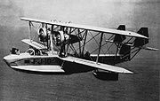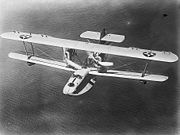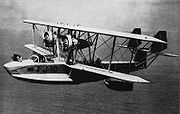
Naval Aircraft Factory PN
Encyclopedia
The Naval Aircraft Factory PN was a series of open cockpit American
United States
The United States of America is a federal constitutional republic comprising fifty states and a federal district...
flying boat
Flying boat
A flying boat is a fixed-winged seaplane with a hull, allowing it to land on water. It differs from a float plane as it uses a purpose-designed fuselage which can float, granting the aircraft buoyancy. Flying boats may be stabilized by under-wing floats or by wing-like projections from the fuselage...
s of the 1920s and 1930s. A development of the Felixstowe F5L
Felixstowe F5L
-See also:-References:NotesBibliography* Bruce, J.M. " Flight, 2 December 1955, pp. 842—846.* Bruce, J.M. " Flight, 16 December 1955, pp. 895—898.* Bruce, J.M. " Flight, 23 December 1955, pp. 929—932....
flying boat of the First World War
World War I
World War I , which was predominantly called the World War or the Great War from its occurrence until 1939, and the First World War or World War I thereafter, was a major war centred in Europe that began on 28 July 1914 and lasted until 11 November 1918...
, variants of the PN were built for the United States Navy
United States Navy
The United States Navy is the naval warfare service branch of the United States Armed Forces and one of the seven uniformed services of the United States. The U.S. Navy is the largest in the world; its battle fleet tonnage is greater than that of the next 13 largest navies combined. The U.S...
by Douglas
Douglas Aircraft Company
The Douglas Aircraft Company was an American aerospace manufacturer, based in Long Beach, California. It was founded in 1921 by Donald Wills Douglas, Sr. and later merged with McDonnell Aircraft in 1967 to form McDonnell Douglas...
, Keystone Aircraft
Keystone Aircraft
Keystone Aircraft Corporation was an early pioneer in airplane manufacturing. Headquartered in Bristol, Pennsylvania, it was formed as Ogdensburg Aeroway Corp in 1920 by Thomas Huff and Elliot Daland, but its name was quickly changed to Huff-Daland Aero Corp, then to the Huff-Daland Aero Company...
and Martin
Glenn L. Martin Company
The Glenn L. Martin Company was an American aircraft and aerospace manufacturing company that was founded by the aviation pioneer Glenn L. Martin. The Martin Company produced many important aircraft for the defense of the United States and its allies, especially during World War II and the Cold War...
.
Development and design
The chief long-range patrol flying boatFlying boat
A flying boat is a fixed-winged seaplane with a hull, allowing it to land on water. It differs from a float plane as it uses a purpose-designed fuselage which can float, granting the aircraft buoyancy. Flying boats may be stabilized by under-wing floats or by wing-like projections from the fuselage...
s of the United States Navy
United States Navy
The United States Navy is the naval warfare service branch of the United States Armed Forces and one of the seven uniformed services of the United States. The U.S. Navy is the largest in the world; its battle fleet tonnage is greater than that of the next 13 largest navies combined. The U.S...
at the end of the First World War
World War I
World War I , which was predominantly called the World War or the Great War from its occurrence until 1939, and the First World War or World War I thereafter, was a major war centred in Europe that began on 28 July 1914 and lasted until 11 November 1918...
were the Curtiss H.16 and the similar Felixstowe F5L
Felixstowe F5L
-See also:-References:NotesBibliography* Bruce, J.M. " Flight, 2 December 1955, pp. 842—846.* Bruce, J.M. " Flight, 16 December 1955, pp. 895—898.* Bruce, J.M. " Flight, 23 December 1955, pp. 929—932....
.

United Kingdom
The United Kingdom of Great Britain and Northern IrelandIn the United Kingdom and Dependencies, other languages have been officially recognised as legitimate autochthonous languages under the European Charter for Regional or Minority Languages...
Felixstowe F.5
Felixstowe F.5
-See also:-References:NotesBibliography* Bruce, J.M. " Flight, 2 December 1955, pp. 842—846.* Bruce, J.M. " Flight, 16 December 1955, pp. 895—898.* Bruce, J.M. " Flight, 23 December 1955, pp. 929—932....
using the American Liberty engine. The series of Felixstowe flying boats, developed by the Seaplane Experimental Station
Seaplane Experimental Station
The Seaplane Experimental Station at Royal Naval Air Station Felixstowe was a British aircraft design unit of the early part of the 20th century.-Creation:...
, had started with improving the hull of the Curtiss H12. The Naval Aircraft Factory
Naval Aircraft Factory
The Naval Aircraft Factory was established by the United States Navy in 1918 at Philadelphia in order to assist in solving the problem of aircraft supply which faced the Navy Department upon the entry of the U.S. into World War I...
, which had built F.5Ls during World War I, continued development of the design, which was re-designated PN-5 in 1922 (although in practice continued to be known as F.5Ls), with the final two being built to an improved design, the F-6L (later designated PN-6). In 1925, the Naval Aircraft Factory produced a version with new wings with an airfoil
Airfoil
An airfoil or aerofoil is the shape of a wing or blade or sail as seen in cross-section....
section of greater maximum lift coefficient. It was powered by experimental 525 hp Wright T-2
Wright Aeronautical
Wright Aeronautical was an aircraft and aircraft engine manufacturer located in New Jersey.-History:This American company evolved from the 1909-1916 Wright Company, which merged with the Glenn L. Martin Company in 1916 to form the Wright-Martin Aircraft Corporation. Glenn Martin resigned from...
piston engines, and was designated PN-7. Although the new wing proved successful, the engines were unreliable, and the wooden hull inherited from the F.5 required much maintenance, so two aircraft with metal hull construction and powered by 475 hp Packard
Packard
Packard was an American luxury-type automobile marque built by the Packard Motor Car Company of Detroit, Michigan, and later by the Studebaker-Packard Corporation of South Bend, Indiana...
engines were built as the PN-8. Further, similar aircraft were built as the PN-9 and PN-10, but the water-cooled V-12 Packard engines were disappointing and radial engine
Radial engine
The radial engine is a reciprocating type internal combustion engine configuration in which the cylinders point outward from a central crankshaft like the spokes on a wheel...
s were substituted to produce the PN-12. This combination of the revised wings introduced by the PN-7, with a metal hull and radial engines met the requirements of the Navy and therefore the PN-12 formed the basis of more extensive production to re-equip its patrol squadrons. As the production capacity of the Naval Aircraft Factory was limited, production was contracted out to several aircraft companies, with versions being built by Douglas
Douglas Aircraft Company
The Douglas Aircraft Company was an American aerospace manufacturer, based in Long Beach, California. It was founded in 1921 by Donald Wills Douglas, Sr. and later merged with McDonnell Aircraft in 1967 to form McDonnell Douglas...
(PD-1), Keystone Aircraft
Keystone Aircraft
Keystone Aircraft Corporation was an early pioneer in airplane manufacturing. Headquartered in Bristol, Pennsylvania, it was formed as Ogdensburg Aeroway Corp in 1920 by Thomas Huff and Elliot Daland, but its name was quickly changed to Huff-Daland Aero Corp, then to the Huff-Daland Aero Company...
(PK-1) and Martin
Glenn L. Martin Company
The Glenn L. Martin Company was an American aircraft and aerospace manufacturing company that was founded by the aviation pioneer Glenn L. Martin. The Martin Company produced many important aircraft for the defense of the United States and its allies, especially during World War II and the Cold War...
(PM-1 and PM-2).
The PN-12 was a twin engined biplane
Biplane
A biplane is a fixed-wing aircraft with two superimposed main wings. The Wright brothers' Wright Flyer used a biplane design, as did most aircraft in the early years of aviation. While a biplane wing structure has a structural advantage, it produces more drag than a similar monoplane wing...
with fabric-covered metal-framed wings, and its engines mounted in nacelle
Nacelle
The nacelle is a cover housing that holds engines, fuel, or equipment on an aircraft. In some cases—for instance in the typical "Farman" type "pusher" aircraft, or the World War II-era P-38 Lightning—an aircraft's cockpit may also be housed in a nacelle, which essentially fills the...
s between the wings. While the hull was constructed of metal, it was otherwise similar to that of the F.5L, with the large sponson
Sponson
Sponsons are projections from the sides of a watercraft, for protection, stability, or the mounting of equipment such as armaments or lifeboats, etc...
s that were a feature of both that aircraft and the Felixstowe and Curtiss flying boats to which it could trace its heritage. It had a standard crew of five, but was capable of carrying a relief crew for long patrols.
The PN-11 featured a revised hull
Hull (watercraft)
A hull is the watertight body of a ship or boat. Above the hull is the superstructure and/or deckhouse, where present. The line where the hull meets the water surface is called the waterline.The structure of the hull varies depending on the vessel type...
which eliminated the sponsons. It also used twin vertical tails
Vertical stabilizer
The vertical stabilizers, vertical stabilisers, or fins, of aircraft, missiles or bombs are typically found on the aft end of the fuselage or body, and are intended to reduce aerodynamic side slip. It is analogical to a skeg on boats and ships.On aircraft, vertical stabilizers generally point upwards...
. Four of this variant were built. They were the basis of the Hall PH
Hall PH
|-See also:-Bibliography:* Donald, David .American Warplanes of World War II. London: Aerospace, 1995. ISBN 1 874023 72 7.* Green, William. War Planes of the Second World War: Volume Five: Flying Boats. London: Macdonald, 1962. ISBN 356 01449 5....
flying boats, some of which remained in service until World War II
World War II
World War II, or the Second World War , was a global conflict lasting from 1939 to 1945, involving most of the world's nations—including all of the great powers—eventually forming two opposing military alliances: the Allies and the Axis...
.
Operational history
The early prototypes were used for a series of long-distance flights, with an attempt being made on 1 September, 1925 by the PN-9 to carry out a non-stop flight from San Francisco to HawaiiHawaii
Hawaii is the newest of the 50 U.S. states , and is the only U.S. state made up entirely of islands. It is the northernmost island group in Polynesia, occupying most of an archipelago in the central Pacific Ocean, southwest of the continental United States, southeast of Japan, and northeast of...
, a distance of 2,400 miles (3864 km). The aircraft ran out of fuel after 1,841 miles, a new distance record for seaplane
Seaplane
A seaplane is a fixed-wing aircraft capable of taking off and landing on water. Seaplanes that can also take off and land on airfields are a subclass called amphibian aircraft...
s, but still 200 miles short of the nearest landfall. The crew then rigged crude sails made from fabric torn from the aircraft's wings and sailed the aircraft a further 450 miles to reach the Hawaiian island of Kauai
Kauai
Kauai or Kauai, known as Tauai in the ancient Kaua'i dialect, is geologically the oldest of the main Hawaiian Islands. With an area of , it is the fourth largest of the main islands in the Hawaiian archipelago, and the 21st largest island in the United States. Known also as the "Garden Isle",...
on 10 September. The same aircraft was lost during an attempted long distance flight to South America
South America
South America is a continent situated in the Western Hemisphere, mostly in the Southern Hemisphere, with a relatively small portion in the Northern Hemisphere. The continent is also considered a subcontinent of the Americas. It is bordered on the west by the Pacific Ocean and on the north and east...
, being sunk as a navigation hazard after ditching in the Caribbean Sea
Caribbean Sea
The Caribbean Sea is a sea of the Atlantic Ocean located in the tropics of the Western hemisphere. It is bounded by Mexico and Central America to the west and southwest, to the north by the Greater Antilles, and to the east by the Lesser Antilles....
. The two PN-12s were also used to set various records, including range and speed over circuit records.
The various production derivatives of the PN-12 entered service with the US Navy from 30 April, 1928, when VP-7D received its first Douglas PD-1, remaining in service until July 1938, when the last Keystone PK-1 was retired.
Three Martin PM-1s were also supplied to the Brazilian Navy
Brazilian Navy
The Brazilian Navy is a branch of the Brazilian Armed Forces responsible for conducting naval operations. It is the largest navy in Latin America...
in 1930.
Variants

- Redesignated Felixstowe F5LFelixstowe F5L-See also:-References:NotesBibliography* Bruce, J.M. " Flight, 2 December 1955, pp. 842—846.* Bruce, J.M. " Flight, 16 December 1955, pp. 895—898.* Bruce, J.M. " Flight, 23 December 1955, pp. 929—932....
PN-6
- Redesignated F-6L. Last two Naval Aircraft Factory F5Ls, modified with revised tail surfaces.
PN-7
- Modified version with new wings with high lift thick aerofoil section and reduced wingspan (72 ft 10 in compared with 103 ft 9 in). Powered by two 525 hp Wright T-2 engines.
PN-8
- PN-7 with metal hull. Powered by two 475 hp Packard 1A-2500 V-12 engines. Two built
PN-9
- Converted from PN-8 with redesigned engine nacelles. One converted.
PN-10
- Similar to PN-8. Powered by two 500hp Packard 1A-2500. Two built.
PN-11
- New hull eliminating sponsons. Four built, one with two Pratt and Whitney R-1690 HornetPratt & Whitney R-1690|-See also:-External links:*...
engines, and remaining three powered by two Wright R-1750 D Cyclone. Last three later re-designated XP4N.
XPN-11
- One prototype, fitted with twin vertical tail surfaces.
PN-12
- Development of PN-10 powered by radial engines. Two built. One powered by two Pratt and Whitney Hornet engines, with the other powered by two Wright R-1750 Cyclone engines.
Douglas PD-1
- Developed production version of PN-12. Two 575 hp Wright R-1750 Cyclone engines. 25 built by Douglas.
Keystone PK-1
- Production version of PN-12. Twin tails. Two 575 hp Wright R-1820 CycloneWright R-1820|-See also:-References:* Bridgman, L, Jane's Fighting Aircraft of World War II. Crescent. ISBN 0-517-67964-7* Eden, Paul & Soph Moeng, The Complete Encyclopedia of World Aircraft. Amber Books Ltd. Bradley's Close, 74-77 White Lion Street, London, NI 9PF, 2002, ISBN 0-7607-3432-1), 1152...
engines. 18 built by Keystone.
Martin PM-1
- Production derivative of PN-12. Two 525 hp Wright R-1750 Cyclone engines. 27 built for US Navy by Martin.
Martin PM-1B
- Export version of PM-1 for Brazil. Three built.
Martin PM-2
- Improved derivative of PM-1 with more powerful Wright R-1820 Cyclone engines and twin tails. 25 built.
Specifications (PN-12)
See also
External links
- http://www.bluejacket.com/usn-usmc_avi_image_vintage_g-z.htm#P
- http://www.cofe.ru/avia/N/N-31.htm
- http://www.history.navy.mil/branches/avchr3.htm

